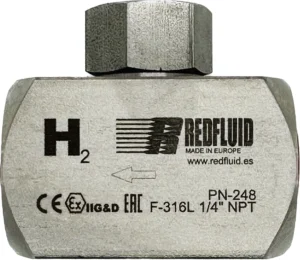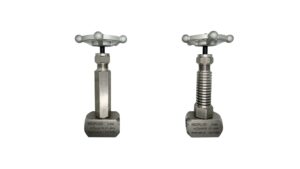
Hydrogen Check Valves
Imagine installing just any check valve in a hydrogen circuit. At first, everything seems to work fine — but over time, internal materials begin to
I love to explain super typical words like, for example, fugitive emission. They are the typical words you hear on TV and read in magazines. Then you don’t even know what they mean. And that’s what I’m here for today. To explain in 5 minutes of nothingness what it means. So let’s go.
Fugitive emission valves or fugitive emission valves are a type of valve used in piping systems to attempt to eliminate the release of fugitive emissions. Fugitive emissions are uncontrolled leaks of gas or vapors from a system. I’ll leave it to you in inspirational quote mode:
Emisiones fugitivas: tipo de válvula que se utiliza en los sistemas de tuberías para intetnar la liberación de emisiones fugitivas.
I say it twice so that it sticks in our heads.
Fugitive emissions are small amounts of gases or liquids that escape from pipes, flanges, valves, tanks, and other equipment. These emissions include gases such as methane, steam, and carbon dioxide, as well as liquids such as oil or water. Fugitive emissions are a major environmental problem. AAAANDD can contribute to air pollution and climate change.
They not only have negative impacts on the environment but also on human health. They can cause respiratory and other health problems for those living near the source of emissions. In addition, fugitive emissions also include greenhouse gases such as methane. Methane is a major contributor to climate change. These emissions not only result in environmental degradation. They also result in the loss of valuable resources and financial losses for companies. In addition, there are also regulatory and legal compliance issues with fugitive emissions. Many countries have laws and regulations that limit the number of emissions that can be released into the atmosphere.
They can occur anywhere in the system but are most common at joints and connections.
Fugitive Emission design valves create a physical barrier between the inside of the valve and the outside atmosphere. This barrier is created by a seal usually located at the top of the valve. When the valve is closed, this seal prevents anything from escaping.
These valves are specially manufactured to pass various tests according to the most stringent standards. The aim: to ensure that they perform their function safely.
It is necessary to differentiate between a production test and a typing test. A production test is performed on valves before they are installed. A type test is a test that is performed on a valve design to check its suitability. The type test validates the design but does not perform the test on the actual valve to be installed.
The most famous production tests are ISO 15848-2 or Shell SPE 77/312 or API 624 or TA Luft – VD 2440. In addition, the tests often require testing the valves several cycles and at different temperature intervals. Ta Luft is so famous that many fugitive emission valves are also called TA Luft valves.
Environmental Protection Agency (EPA) VOC regulations in the United States of America: The EPA sets limits on the amount of volatile organic compounds (VOCs) that can be released into the atmosphere. These regulations apply to a wide range of industries. They include the oil and gas industry covering fugitive emissions from valves and other equipment.
The European Union (EU) Industrial Emissions Directive (IED) and the Industrial Emissions Regulation (IER) set limits on the number of fugitive emissions from valves and other equipment in the oil and gas industry within Europe.
Well, let’s move on from regulations that we have a few. If you have any more you can leave them in the comments.
There are several reasons why you should consider installing fugitive emissions-compliant valves:
Overall, installing fugitive emissions compliance valves can help you meet regulatory standards. Plus, you’ll protect the environment, save money and improve the safety of your operations. And don’t forget that you can enhance your company’s reputation.
Needle valves are used to control the flow rate through a pipeline and are often part of the instrumentation lines of a system. They are also an important component in the control of fugitive emissions. Needle valves operate using a long stem that allows precise and tight control of the amount of flow allowed through the valve. They are ideal for instrumentation panels and high-pressure circuits.
At Redfluid we have special needle valves designed and tested to meet the requirements of standards such as API 624 or ISO 15848 and can be considered as needle valves to prevent fugitive emissions. These valves can be used in various applications such as the production, storage, and transportation of steam, gas, hydrogen, and oil as well as in other industries where the control of fugitive emissions is important. Learn more about Redfluid needle valves here.
Fugitive emission ball valves work by blocking the flow of gas through a ball that is connected to a handle. Ball valves are easy to open and close. They can be used in both high and low-pressure applications. At Redfluid we have a wide range of valves designed and tested according to different fugitive emission standards. Discover Redfluid ball valves here.
Although it may seem that the combination of these certifications in a single valve is very rare or impossible to find, a Fugitive Emission, ATEX, and Fire Safe valve do exist. And we say this with confidence because we have it. We have a needle, check, and ball valves that meet all three standards.
However, it is important for you to know that each certification is different from the others. The fact that a valve is Fugitive Emission does not mean that it is also ATEX. They are two very different things, although they are compatible. We share with you all the details about ATEX certification here.
The answer is yes. A valve can be designed to be both fugitive emission, ATEX and Fire Safe.
Fugitive emission valves are designed to minimize the number of gases or liquids escaping from pipelines or storage tanks. In addition, they meet regulatory standards such as API 624, ISO 15848, and others. Fire Safe is designed to prevent the release of hazardous materials in the event of a fire. ATEX valves are designed to comply with the European Union (EU) directive on equipment and protective systems for use in potentially explosive atmospheres.
At Redfluid we have valves that meet the requirements of these three categories. They incorporate features such as flame-retardant stem seals, which prevent the release of fluid in the event of a fire, tight tolerance ball or needle design, which helps minimize the amount of fluid leaking through the valve when closed, thus reducing the number of fugitive emissions, and ATEX certifications that ensure the valve is suitable for use in potentially explosive atmospheres.
And you know, if you need any other kind of info click HERE AND CONTACT US.
Share this post

Imagine installing just any check valve in a hydrogen circuit. At first, everything seems to work fine — but over time, internal materials begin to

You’ve probably heard about high-temperature or cryogenic valves, the ones that are incredibly resistant because they operate under extreme conditions. But what makes them so
This website uses cookies so that we can provide you with the best user experience possible. Cookie information is stored in your browser and performs functions such as recognising you when you return to our website and helping our team to understand which sections of the website you find most interesting and useful.
Strictly Necessary Cookie should be enabled at all times so that we can save your preferences for cookie settings.
If you disable this cookie, we will not be able to save your preferences. This means that every time you visit this website you will need to enable or disable cookies again.
Esta web utiliza Google Analytics para recopilar información anónima tal como el número de visitantes del sitio, o las páginas más populares.
Dejar esta cookie activa nos permite mejorar nuestra web.
Please enable Strictly Necessary Cookies first so that we can save your preferences!